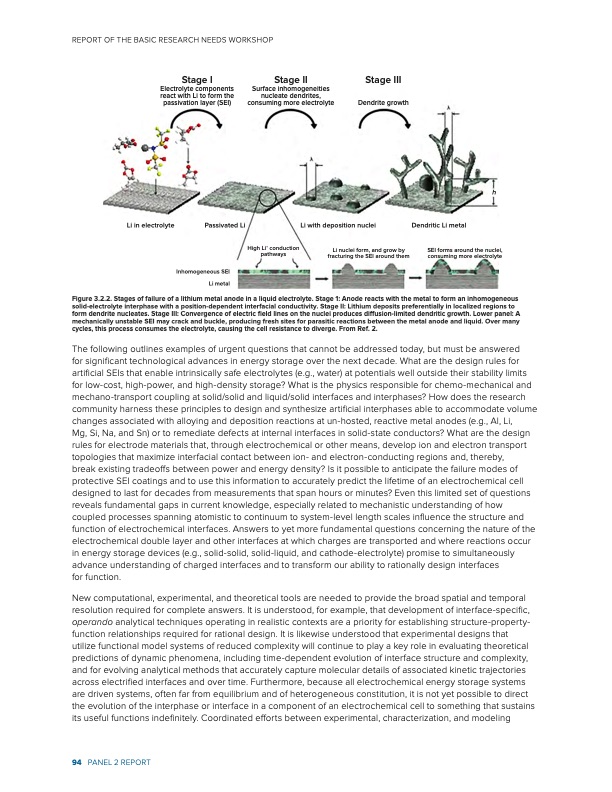
PDF Publication Title:
Text from PDF Page: 100
REPORT OF THE BASIC RESEARCH NEEDS WORKSHOP Li in electrolyte Passivated Li Inhomogeneous SEI Li metal Li with deposition nuclei Li nuclei form, and grow by fracturing the SEI around them Dendritic Li metal Stage I Electrolyte components react with Li to form the passivation layer (SEI) Stage II Surface inhomogeneities nucleate dendrites, consuming more electrolyte Stage III Dendrite growth High Li+ conduction pathways SEI forms around the nuclei, consuming more electrolyte Figure 3.2.2. Stages of failure of a lithium metal anode in a liquid electrolyte. Stage 1: Anode reacts with the metal to form an inhomogeneous solid-electrolyte interphase with a position-dependent interfacial conductivity. Stage II: Lithium deposits preferentially in localized regions to form dendrite nucleates. Stage III: Convergence of electric field lines on the nuclei produces diffusion-limited dendritic growth. Lower panel: A mechanically unstable SEI may crack and buckle, producing fresh sites for parasitic reactions between the metal anode and liquid. Over many cycles, this process consumes the electrolyte, causing the cell resistance to diverge. From Ref. 2. The following outlines examples of urgent questions that cannot be addressed today, but must be answered for significant technological advances in energy storage over the next decade. What are the design rules for artificial SEIs that enable intrinsically safe electrolytes (e.g., water) at potentials well outside their stability limits for low-cost, high-power, and high-density storage? What is the physics responsible for chemo-mechanical and mechano-transport coupling at solid/solid and liquid/solid interfaces and interphases? How does the research community harness these principles to design and synthesize artificial interphases able to accommodate volume changes associated with alloying and deposition reactions at un-hosted, reactive metal anodes (e.g., Al, Li, Mg, Si, Na, and Sn) or to remediate defects at internal interfaces in solid-state conductors? What are the design rules for electrode materials that, through electrochemical or other means, develop ion and electron transport topologies that maximize interfacial contact between ion- and electron-conducting regions and, thereby, break existing tradeoffs between power and energy density? Is it possible to anticipate the failure modes of protective SEI coatings and to use this information to accurately predict the lifetime of an electrochemical cell designed to last for decades from measurements that span hours or minutes? Even this limited set of questions reveals fundamental gaps in current knowledge, especially related to mechanistic understanding of how coupled processes spanning atomistic to continuum to system-level length scales influence the structure and function of electrochemical interfaces. Answers to yet more fundamental questions concerning the nature of the electrochemical double layer and other interfaces at which charges are transported and where reactions occur in energy storage devices (e.g., solid-solid, solid-liquid, and cathode-electrolyte) promise to simultaneously advance understanding of charged interfaces and to transform our ability to rationally design interfaces for function. New computational, experimental, and theoretical tools are needed to provide the broad spatial and temporal resolution required for complete answers. It is understood, for example, that development of interface-specific, operando analytical techniques operating in realistic contexts are a priority for establishing structure-property- function relationships required for rational design. It is likewise understood that experimental designs that utilize functional model systems of reduced complexity will continue to play a key role in evaluating theoretical predictions of dynamic phenomena, including time-dependent evolution of interface structure and complexity, and for evolving analytical methods that accurately capture molecular details of associated kinetic trajectories across electrified interfaces and over time. Furthermore, because all electrochemical energy storage systems are driven systems, often far from equilibrium and of heterogeneous constitution, it is not yet possible to direct the evolution of the interphase or interface in a component of an electrochemical cell to something that sustains its useful functions indefinitely. Coordinated efforts between experimental, characterization, and modeling 94 PANEL 2 REPORT hPDF Image | Next Generation Electrical Energy Storage

PDF Search Title:
Next Generation Electrical Energy StorageOriginal File Name Searched:
BRN-NGEES_rpt-low-res.pdfDIY PDF Search: Google It | Yahoo | Bing
Sulfur Deposition on Carbon Nanofibers using Supercritical CO2 Sulfur Deposition on Carbon Nanofibers using Supercritical CO2. Gamma sulfur also known as mother of pearl sulfur and nacreous sulfur... More Info
CO2 Organic Rankine Cycle Experimenter Platform The supercritical CO2 phase change system is both a heat pump and organic rankine cycle which can be used for those purposes and as a supercritical extractor for advanced subcritical and supercritical extraction technology. Uses include producing nanoparticles, precious metal CO2 extraction, lithium battery recycling, and other applications... More Info
| CONTACT TEL: 608-238-6001 Email: greg@infinityturbine.com | RSS | AMP |